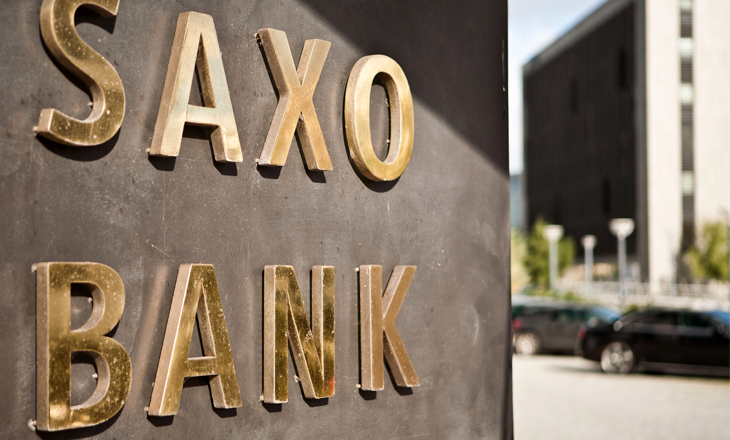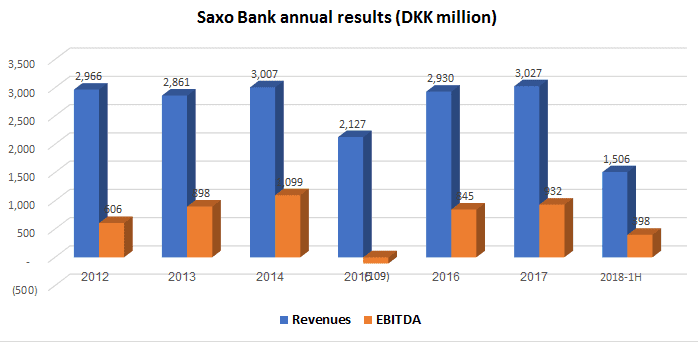Copenhagen based Retail FX and CFDs broker Saxo Bank has reported its results for the first half of 2018, indicating an overall slowdown in business.
On the top line, in what the company said was a period with low market volatility and the introduction of a new competitive pricing structure, Revenue for the Group reached DKK 1.51 billion (USD $230 million), a slight decrease of 0.3% compared to the first half of 2017 (although up slightly from the second half of 2017 at Saxo Bank).
Saxo Bank reported a positive net profit of DKK 150 million for the first six months of 2018, down from DKK 230 million last year 1H.
Client collateral deposits did continue to rise to DKK 110.4 billion, representing an increase of 7% compared to the end of 2017.
Financial highlights for the first half of 2018 at Saxo included:
- Operating income: DKK 1,506.4 million (DKK 1,557.6 million H1 2017)
- EBITDA: DKK 397.9 million (DKK 495.9 million H1 2017)
- Adjusted EBITDA: DKK 431.2 million (DKK 550.4 million H1 2017)
- Profit before tax: DKK 209.4 million (DKK 312.2 million H1 2017)
- Net profit: DKK 149.7 million (DKK 229.5 million H1 2017)
- Clients’ collateral deposits: DKK 110.4 billion (DKK 103.6 billion at the end of 2017)
- Total equity: DKK 4,763.3 million (DKK 4,621.4 million at the end of 2017)
- Total capital ratio: 27.6% (22.7% at the end of 2017)

Kim Fournais, Saxo Bank
Commenting on the results, Kim Fournais, CEO and co-founder of Saxo Bank, said:
The results reflect the low levels of volatility across financial markets that have marked the first half of the year. Another contributing factor is the introduction of a new and more transparent pricing structure that lowers prices significantly across asset classes in several key markets. Despite an immediate impact on income, it has resulted in an increase in new trading clients and reaffirms our long-term growth strategy of competing on product, platform, price and service.
We continue to develop and invest in our product offering and technology to improve the Saxo experience for traders, investors, and partners. The launch of SaxoTraderPRO brings a variety of customizable trading tools to active traders and institutional clients. Catering to the investor segment, we have added mutual funds as a new asset class on our platform which now facilitates access to more than 35,000 tradeable instruments.
For the rest of the year, we remain dedicated to continuously improving our products, platforms and service and helping clients and partners succeed.
In October 2017 it was announced that Geely Financials Denmark A/S, a subsidiary of China’s Zhejiang Geely Holding Group Co., Ltd (or, “Geely Group”) offered to buy 51.5% of the shares in Saxo Bank, with Sampo Group, a leading Nordic financial services group, offering to buy 19.9% of the bank. The process of closing the transactions is pending final regulatory approvals and has been subject to approvals from 11 different financial and competition authorities.
Saxo Bank has had a very busy start to the year. Saxo Bank made the interesting move of transferring its entire banking platform and technology stack to Microsoft Cloud. And the new China-based ownership group at Saxo Bank – while yet to formally take over, as final regulatory approvals are received as noted above – is already making its mark on the company by paring assets such as an exit from the South Africa FX market, while expanding further in China by partnering with SINA Corp’s Valuable Capital, and in Italy via a joint venture with Banca Generali. During July, Saxo Bank continued its streamlining and sold its Banking Circle payments unit to Swedish private equity firm EQT partners.
Saxo Bank’s full 1H-2018 report can be seen here (pdf).

